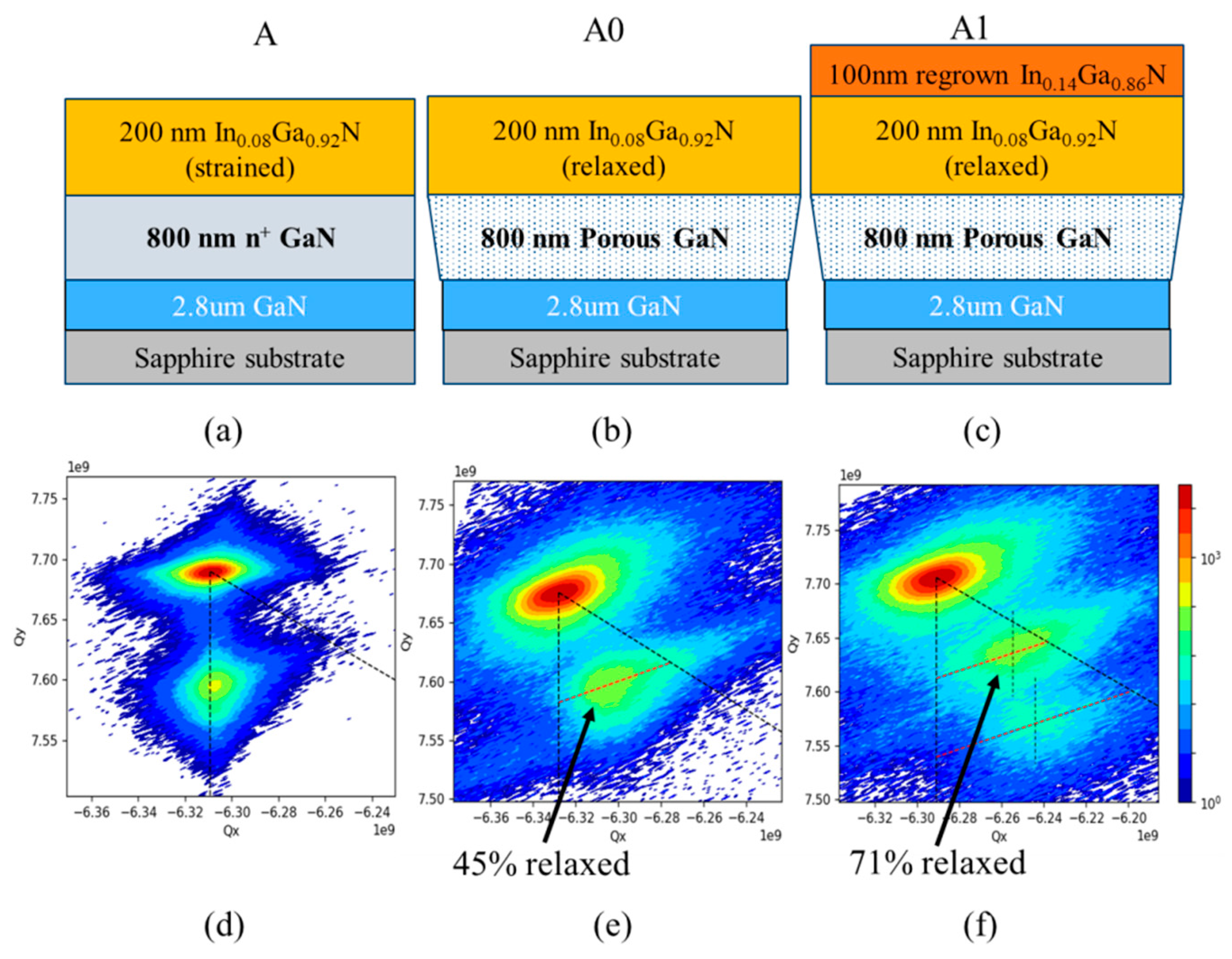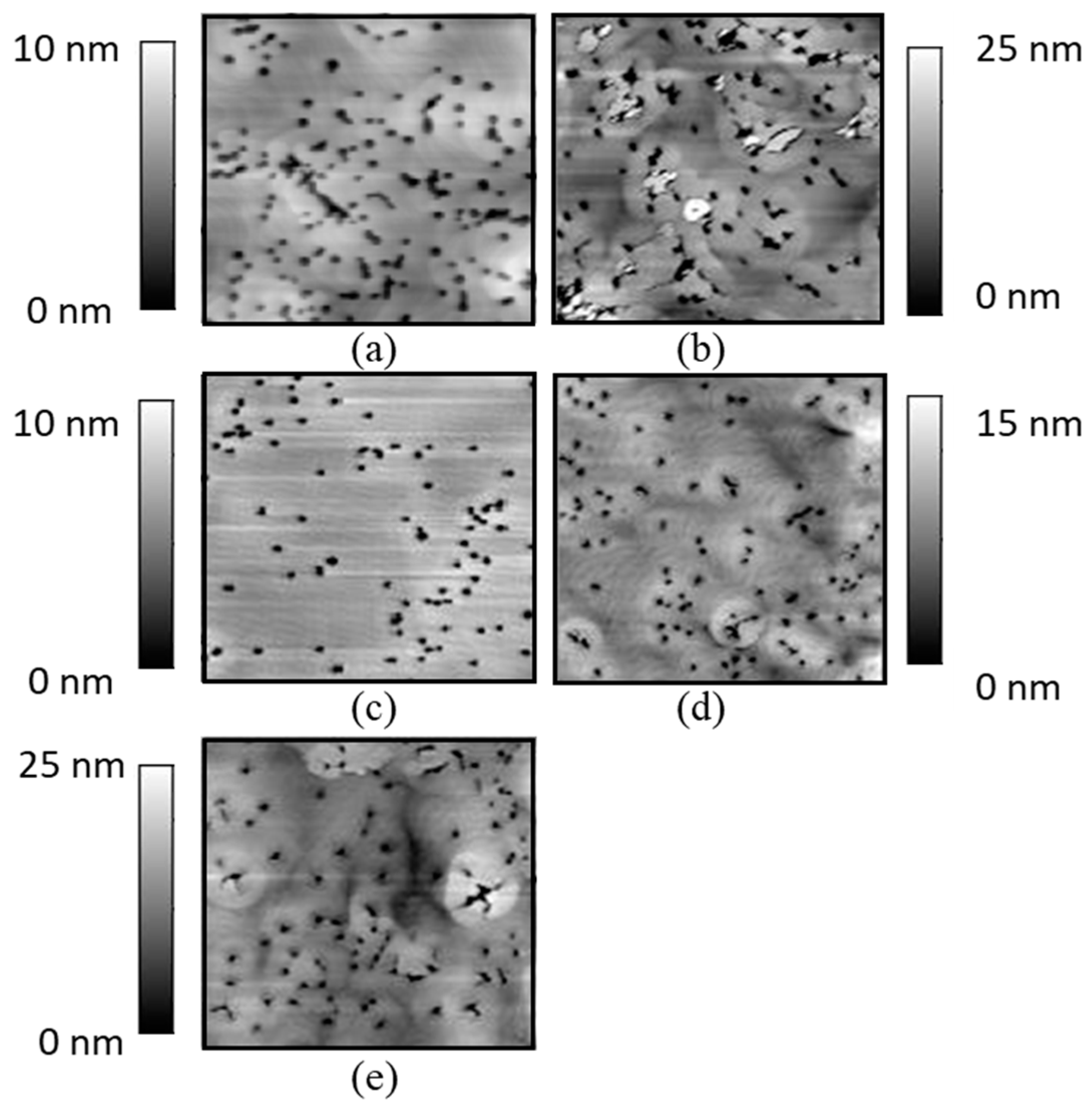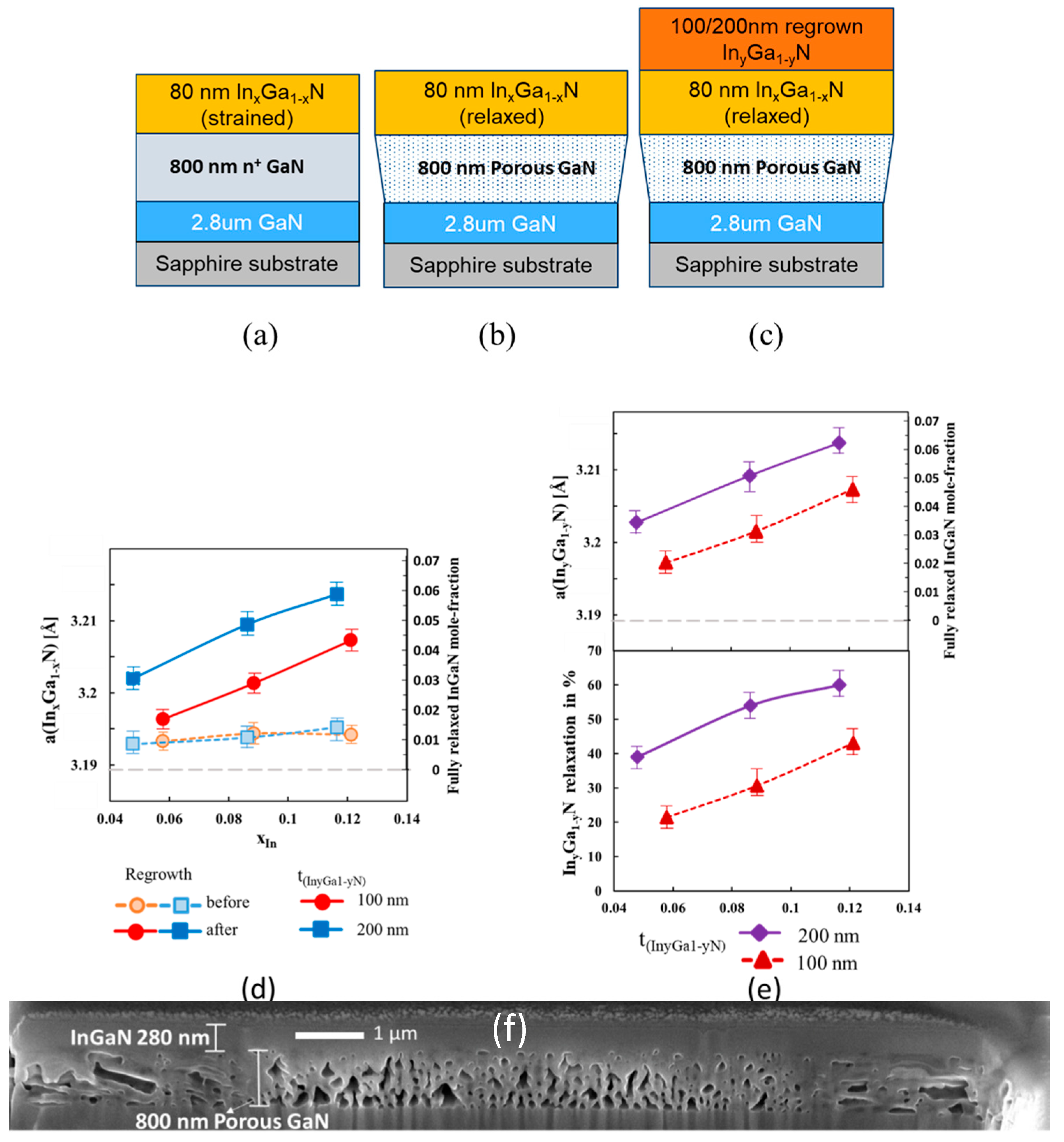Compliant Micron-Sized Patterned InGaN Pseudo-Substrates Utilizing Porous GaN
Abstract
1. Introduction
2. Materials and Methods
3. Results and Discussion
3.1. Experiment 1: InxGa1−xN Layer Thickness 200 nm (Sample Series A)
3.2. Experiment 2: InxGa1−xN Layer Thickness 80 nm, with Varying ‘x’ (Sample Series B, C and D)
3.3. Morphology Analysis Based on V Defect Density
4. Conclusions
Author Contributions
Funding
Acknowledgments
Conflicts of Interest
References
- Maur, M.A.; Pechhia, A.; Penazzi, G.; Rodrigues, W.; Carlo, A.D. Efficiency Drop in Green InGaN/GaN Light Emitting Diodes: The Role of Random Alloy Fluctuations. Phys. Rev. Lett. 2016, 116, 027401. [Google Scholar] [CrossRef]
- Matthews, J.W.; Blakeslee, A.E. Defects in epitaxial multilayers: I. Misfit dislocations. J. Cryst. Growth 1974, 27, 118–125. [Google Scholar] [CrossRef]
- Holec, D.; Costa, P.M.F.J.; Kappers, M.J.; Humphreys, C.J. Critical thickness calculation for InGaN/GaN. J. Cryst. Growth 2007, 303, 314–317. [Google Scholar] [CrossRef]
- Kawaguchi, Y.; Shimizu, M.; Hiramatsu, K.; Sawaki, N. The Composition Pulling Effect in InGaN Growth on the GaN and AlGaN Epitaxial Layers Grown by MOVPE. In Proceedings of the Materials Research Society Symposium, Boston, MA, USA, 2 December 1996; Volume 449. [Google Scholar]
- Yayama, T.; Kangawa, Y.; Kakimoto, K.; Koukitu, A. Theoretical analyses of In incorporation and compositional instability in coherently grown InGaN thin films. Phys. Status Solidi C 2010, 7, 2249. [Google Scholar] [CrossRef]
- Even, A.; Laval, G.; Ledoux, O.; Ferret, P.; Sotta, D.; Guiot, E.; Levy, F.; Robin, I.C.; Dussaigne, A. Enhanced In incorporation in full InGaN heterostructure grown on relaxed InGaN pseudo-substrate. Appl. Phys. Lett. 2017, 110, 262103. [Google Scholar] [CrossRef]
- Pereira, S.; Correia, M.R.; Pereira, E.; O’Donnel, K.P.; Trager-Cowan, C.; Sweeny, F.; Alves, E. Compositional pulling effects in InxGa1-xN/GaN layers: A combined depth-resolved cathodoluminescence and Rutherford backscattering/channeling study. Phys. Rev. B 2011, 64, 205311. [Google Scholar] [CrossRef]
- Hiramatsu, K.; Kawaguchi, Y.; Shimizu, M.; Sawaki, N.; Zheleva, T.; Davis, R.F.; Tsuda, H.; Taki, W.; Kuwano, N.; Oki, K. The Composition Pulling Effect in MOVPE Grown InGaN on GaN and AlGaN and its TEM Characterization. MRS Internet J. Nitride Semicond. 1997, 2, e6. [Google Scholar] [CrossRef]
- Däubler, J.; Passow, T.; Aidam, R.; Köhler, K.; Kirste, L.; Kunzer, M.; Wagner, J. Long wavelength emitting GaInN quantum wells on metamorphic GaInN buffer layers with enlarged in-plane lattice parameter. Appl. Phys. Lett. 2014, 105, 111111. [Google Scholar] [CrossRef]
- Pasayat, S.S.; Gupta, C.; James, D.A.; Cohen, D.; DenBaars, S.P.; Nakamura, S.; Keller, S.; Mishra, U.K. Fabrication of relaxed InGaN pseudo-substrates composed of micron-sized pattern arrays with high fill factors using porous GaN. Semicond. Sci. Technol. 2019, 34, 115020. [Google Scholar] [CrossRef]
- Kobayashi, A.; Ohta, J.; Fujioka, H. Low temperature epitaxial growth of In0.25Ga0.75N on lattice-matched ZnO by pulsed laser deposition. J. Appl. Phys. 2006, 99, 123513. [Google Scholar] [CrossRef]
- Wang, S.J.; Li, N.; Park, E.H.; Feng, Z.C.; Valencia, A.; Nause, J.; Kane, M.; Summers, C.; Ferguson, I. MOCVD growth of GaN-based materials on ZnO substrates. Phys. Status Solidi C 2008, 5, 1736–1739. [Google Scholar] [CrossRef]
- Lei, Y.; Xu, J.; Zhu, K.; He, M.; Zhou, J.; Gao, Y.; Zhang, L.; Chen, Y. A GaN-Based LED With Perpendicular Structure Fabricated on a ZnO Substrate by MOCVD. J. Disp. Technol. 2013, 9, 377–381. [Google Scholar] [CrossRef]
- Ozaki, T.; Takagi, Y.; Nishinaka, J.; Funato, M.; Kawakami, Y. Metalorganic vapor phase epitaxy of GaN and lattice-matched InGaN on ScAlMgO4 (0001) substrates. Appl. Phys. Express 2014, 7, 091001. [Google Scholar] [CrossRef]
- Ozaki, T.; Funato, M.; Kawakami, Y. InGaN-based visible light emitting diodes on ScAlMgO4 (0001) substrates. Appl. Phys. Express 2015, 8, 062101. [Google Scholar] [CrossRef]
- Hestroffer, K.; Wu, F.; Li, H.; Lund, C.; Keller, S.; Speck, J.S.; Mishra, U.K. Relaxed c-plane InGaN layers for the growth of strain-reduced InGaN quantum wells. Semicond. Sci. Technol. 2015, 30, 105015. [Google Scholar] [CrossRef]
- Lund, C.; Hestroffer, K.; Hatui, N.; Nakamura, S.; DenBaars, S.P.; Mishra, U.K.; Keller, S. Digital growth of thick N-polar InGaN films on relaxed InGaN pseudosubstrates. Appl. Phys. Express 2017, 10, 111001. [Google Scholar] [CrossRef]
- Keller, S.; Lund, C.; Whyland, T.; Hu, Y.; Neufeld, C.; Chan, S.; Wienecke, S.; Wu, F.; Nakamura, S.; Speck, J.S.; et al. InGaN lattice constant engineering via growth on (In, Ga) N/GaN nanostripe arrays. Semicond. Sci. Technol. 2015, 30, 105020. [Google Scholar] [CrossRef]
- Zhang, J.; Tansu, N. Improvement in spontaneous emission rates for InGaN quantum wells on ternary InGaN substrate for light-emitting diodes. J. Appl. Phys. 2011, 110, 113110. [Google Scholar] [CrossRef]
- Zhang, J.; Tansu, N. Optical Gain and Laser Characteristics of InGan Quantum Wells on Ternary InGaN Substrates. IEEE Photonics J. 2011, 5, 2600111. [Google Scholar] [CrossRef]
- Pal, J.; Migliorato, M.A.; Li, C.K.; Wu, Y.R.; Crutchley, B.G.; Marko, I.P.; Sweeney, S.J. Enhancement of efficiency of InGaN-ased light emitting diodes through strain and piezoelectric field management. J. Appl. Phys. 2013, 114, 073104. [Google Scholar] [CrossRef]
- Sharma, T.K.; Towe, E. On ternary nitride substrates for visible semiconductor light-emitters. Appl. Phys. Lett. 2010, 96, 191105. [Google Scholar] [CrossRef]
- Park, S.H.; Moon, Y.T.; Lee, J.S.; Kwon, H.K.; Speck, J.S.; Ahn, D. Spontaneous emission rate of green strain-compensated InGAN/InGaN LEDs using InGaN substrate. Phys. Status Solidi A 2011, 208, 195–198. [Google Scholar] [CrossRef]
- Keller, S.; Schaake, C.; Fichtenbaum, N.A.; Neufeld, C.J.; Wu, Y.; McGroddy, K.; David, A.; DenBaars, S.P.; Weisbuch, C.; Speck, J.S.; et al. Optical and structural properties of GaN nanopillar and nanostripe arrays with embedded InGaN/GaN multi-quantum wells. J. Appl. Phys. 2006, 100, 054314. [Google Scholar] [CrossRef]
- Gupta, C.; Tsukada, Y.; Romanczyk, B.; Pasayat, S.S.; James, D.A.; Ahmadi, E.; Keller, S.; Mishra, U.K. First demonstration of improvement in hole conductivity in c-plane III-Nitrides through application of uniaxial strain. Jpn. J. Appl. Phys. 2019, 58, 030908. [Google Scholar] [CrossRef]
- Zhang, Yu.; Ryu, S.W.; Yerino, C.; Leung, B.; Sun, Q.; Cao, H.; Han, J. A conductivity-based selective etching for next generation GaN devices. Phys. Status Solidi B 2010, 247, 1713–1716. [Google Scholar] [CrossRef]
- Won, D.; Weng, X.; Redwing, J.M. Effect of indium surfactant on stress relaxation by V-defect formation in GaN epilayers grown by metalorganic chemical vapor deposition. J. Appl. Phys. 2010, 108, 093511. [Google Scholar] [CrossRef]
- Wu, X.H.; Elsass, C.R.; Abare, A.; Mack, M.; Keller, S.; Petroff, P.M.; DenBaars, S.P.; Speck, J.S. Structural origin of V-defects and correlation with localized excitonic centers in InGaN/GaN multiple quantum wells. Appl. Phys. Lett. 1998, 72, 692. [Google Scholar] [CrossRef]
- Rhode, S.L.; Fu, W.Y.; Moram, M.A.; Massabuau, F.C.P.; Kappers, M.J.; McAleese, C.; Oehler, F.; Humphreys, C.J.; Dusane, R.O.; Sahonta, S.L. Structural and strain relaxation effects of defects in InxGa1-xN epilayers. J. Appl. Phys. 2014, 116, 103513. [Google Scholar] [CrossRef]
- Fischer, A.; Kiihne, H.; Roos, B.; Richter, H. Elastic strain relaxation in patterned heteroepitaxial structures. Semicond. Sci. Technol. 1994, 9, 2195–2198. [Google Scholar] [CrossRef]
- Cho, H.K.; Lee, J.Y.; Kim, C.S.; Yang, G.M.; Sharma, N.; Humphreys, C. Microstructural characterization of InGaN/GaN multiple quantum wells with high indium composition. J. Cryst. Growth 2001, 231, 466–473. [Google Scholar] [CrossRef]
- Jiang, F.; Xhang, J.; Xu, L.; Ding, J.; Wang, G.; Wu, X.; Wang, X.; Mo, C.; Quan, Z.; Guo, X.; et al. Efficient InGaN-based yellow-light-emitting diodes. Photon. Res. 2019, 7, 144–148. [Google Scholar] [CrossRef]
- Oliver, R.A.; Kappers, M.J.; Humphreys, C.J. Growth modes in heteroepitaxy of InGaN on GaN. J. Appl. Phys. 2005, 97, 013707. [Google Scholar] [CrossRef]
- Kobayashi, Y.; Perez-Solorzano, V.; Off, J.; Kuhn, B.; Gräbeldinger, H.; Schweizer, H.; Scholz, F. Investigations of growth of self-assembled GaInN-GaN islands on SiC substrate by metalorganic vapor phase epitaxy. J. Cryst. Growth 2002, 243, 103–107. [Google Scholar] [CrossRef]




© 2020 by the authors. Licensee MDPI, Basel, Switzerland. This article is an open access article distributed under the terms and conditions of the Creative Commons Attribution (CC BY) license (http://creativecommons.org/licenses/by/4.0/).
Share and Cite
Pasayat, S.S.; Gupta, C.; Wang, Y.; DenBaars, S.P.; Nakamura, S.; Keller, S.; Mishra, U.K. Compliant Micron-Sized Patterned InGaN Pseudo-Substrates Utilizing Porous GaN. Materials 2020, 13, 213. https://doi.org/10.3390/ma13010213
Pasayat SS, Gupta C, Wang Y, DenBaars SP, Nakamura S, Keller S, Mishra UK. Compliant Micron-Sized Patterned InGaN Pseudo-Substrates Utilizing Porous GaN. Materials. 2020; 13(1):213. https://doi.org/10.3390/ma13010213
Chicago/Turabian StylePasayat, Shubhra S., Chirag Gupta, Yifan Wang, Steven P. DenBaars, Shuji Nakamura, Stacia Keller, and Umesh K. Mishra. 2020. "Compliant Micron-Sized Patterned InGaN Pseudo-Substrates Utilizing Porous GaN" Materials 13, no. 1: 213. https://doi.org/10.3390/ma13010213
APA StylePasayat, S. S., Gupta, C., Wang, Y., DenBaars, S. P., Nakamura, S., Keller, S., & Mishra, U. K. (2020). Compliant Micron-Sized Patterned InGaN Pseudo-Substrates Utilizing Porous GaN. Materials, 13(1), 213. https://doi.org/10.3390/ma13010213






